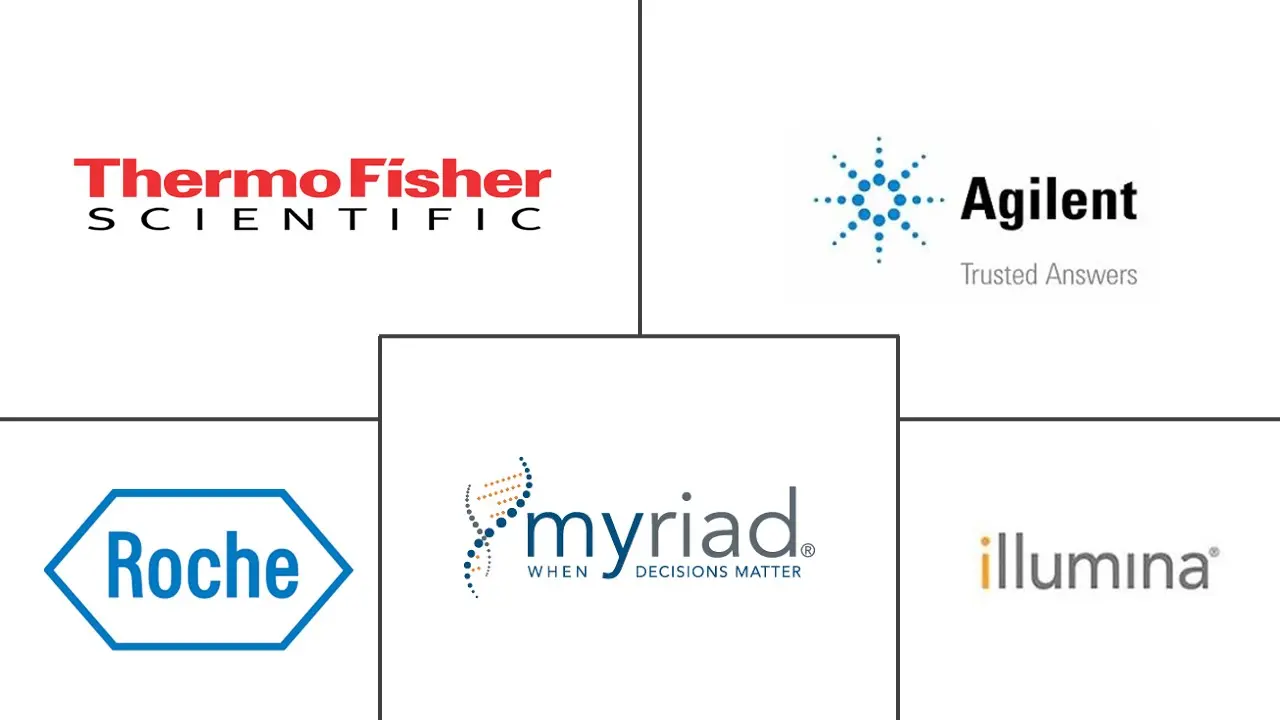Market Size of Global Clinical Oncology NGS Industry

| Study Period | 2019 - 2029 |
| Base Year For Estimation | 2023 |
| CAGR | 16.90 % |
| Fastest Growing Market | North America |
| Largest Market | Asia-Pacific |
| Market Concentration | Medium |
Major Players
*Disclaimer: Major Players sorted in no particular order |
Need a report that reflects how COVID-19 has impacted this market and its growth?
Clinical Oncology NGS Market Analysis
The Clinical Oncology NGS Market is expected to grow at the registered CAGR of 16.9% during the forecast period, 2022-2027.
COVID-19 significantly impacts the clinical oncology NGS market. The guidelines issued by the government of different countries for availing the treatment of cancer during the pandemic are also driving the market's growth. For instance, the Ministry of Health and Family Welfare (MOHFW), the Government of India, released guidelines in March 2020, reporting that Cancer treatment is considered a high priority essential non-COVID-19 healthcare facility. However, a National Cancer Institute article in March 2021 reported that cancer screening decreased during COVID-19. Additionally, The NGS diagnostic technology has the potential advantage of determining the genetic sequence of a virus and helping scientists understand the mutations. Throughout the COVID-19 pandemic, government authorities worldwide constantly work with the private sector to bring NGS technology as a potential diagnostic tool into the market. For instance, in June 2020, the United States Food and Drug Administration (USFDA) issued an emergency use authorization (EUA) to Illumina Inc. for the first COVID-19 diagnostic test utilizing next-generation sequence technology.
The global clinical oncology next-generation sequencing market is driven by factors such as the growing popularity of personalized medicine in clinical oncology, decreasing in cost of genetic medicine, the rising prevalence of cancer, the growing need for early cancer diagnosis and treatment, and the continued advancements in cancer research.
Personalized medicine involves the use of an individual's genetic profile (genome) in the prevention, diagnosis, and treatment of diseases and has the potential to offer the best response and highest safety to ensure better result outcomes. The market is expected to grow with advancements in precision therapies and diagnostics, coupled with breakthrough innovations, such as Next Generation Sequencing (NGS). Moreover, the rise in clinical applications of next-generation sequencing in precision oncology has fueled key companies' efforts to develop novel platforms for genomic assays. For instance, in February 2021, Gabriel Precision Oncology Ltd. and Congenica collaborated to develop an automatic clinical oncology interpretation software platform. Such developments are expected to boost the growth of the market.
Increasing cancer prevalence is driving the global clinical oncology next generation sequencing market. For Instance, According to Global Cancer Observatory (GLOBOCAN 2020) report, there were an estimated 19,292,789 new cancer cases and 9,958,133 deaths globally due to cancers. The breast cancer accounting for 2,261,419 new cancer cases in 2020, followed by lung (2,206,771), colorectum (1,931,590), prostate (1,414,259) and stomach (1,089,103) new cancer cases in 2020 worldwide.
Another factor boosting the market's growth is the reduction in the cost of NGS platforms. Clinical oncology next-generation sequencing techniques provide a high percentage of reads and low cost per reading. Leading players are introducing low-cost sequencing techniques. According to the study titled "Innovation at Illumina: The road to the USD 600 human genome," published in the Nature Portfolio in February 2021, A human genome can now be sequenced for USD 600 (down from USD 10,000 previously), with some speculating that a USD 100 genome is not far behind. Human genome sequencing has become more affordable, allowing researchers and clinicians to apply their knowledge to studying diseases and phenotypes.
Thus, all the aforementioned factors are expected to boost the market over the forecast period. However, lack of computational efficiency for data management and inadequate reimbursement policy are the major restraining factors for the market studied.
